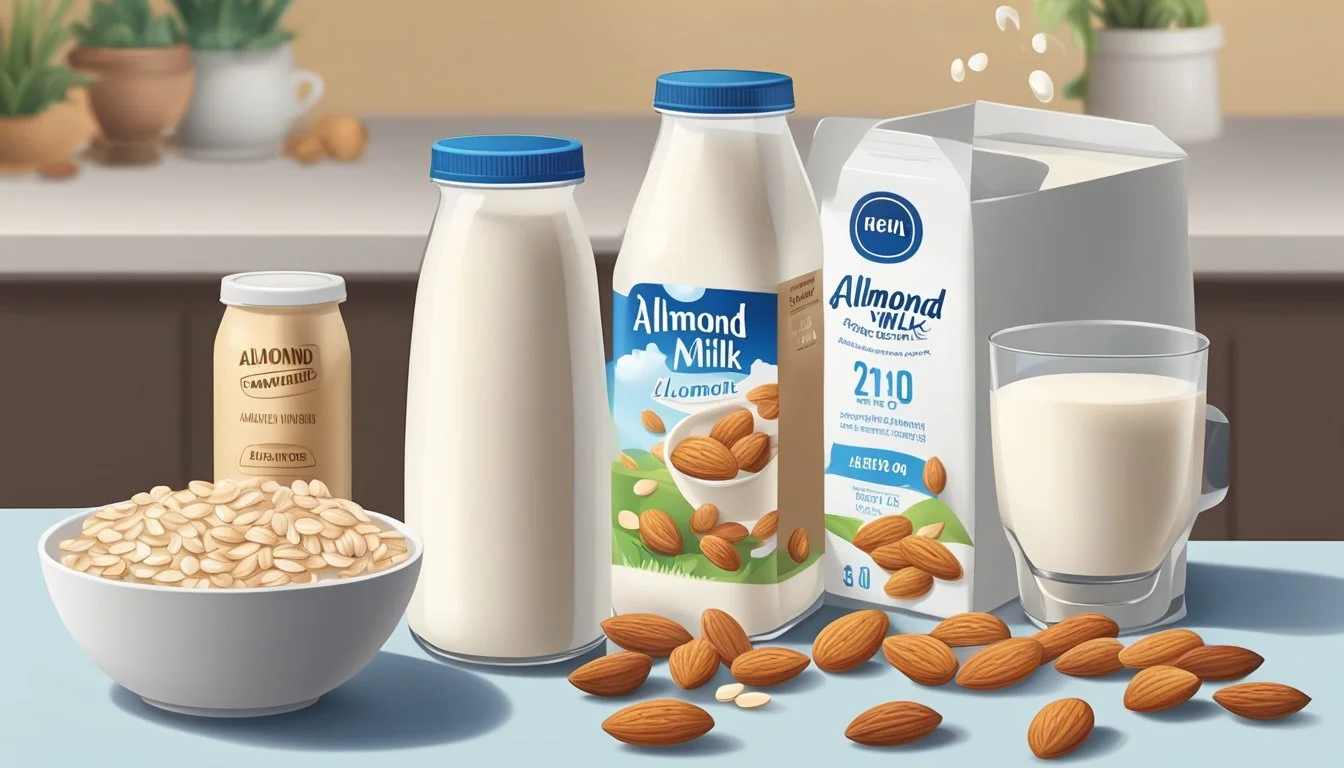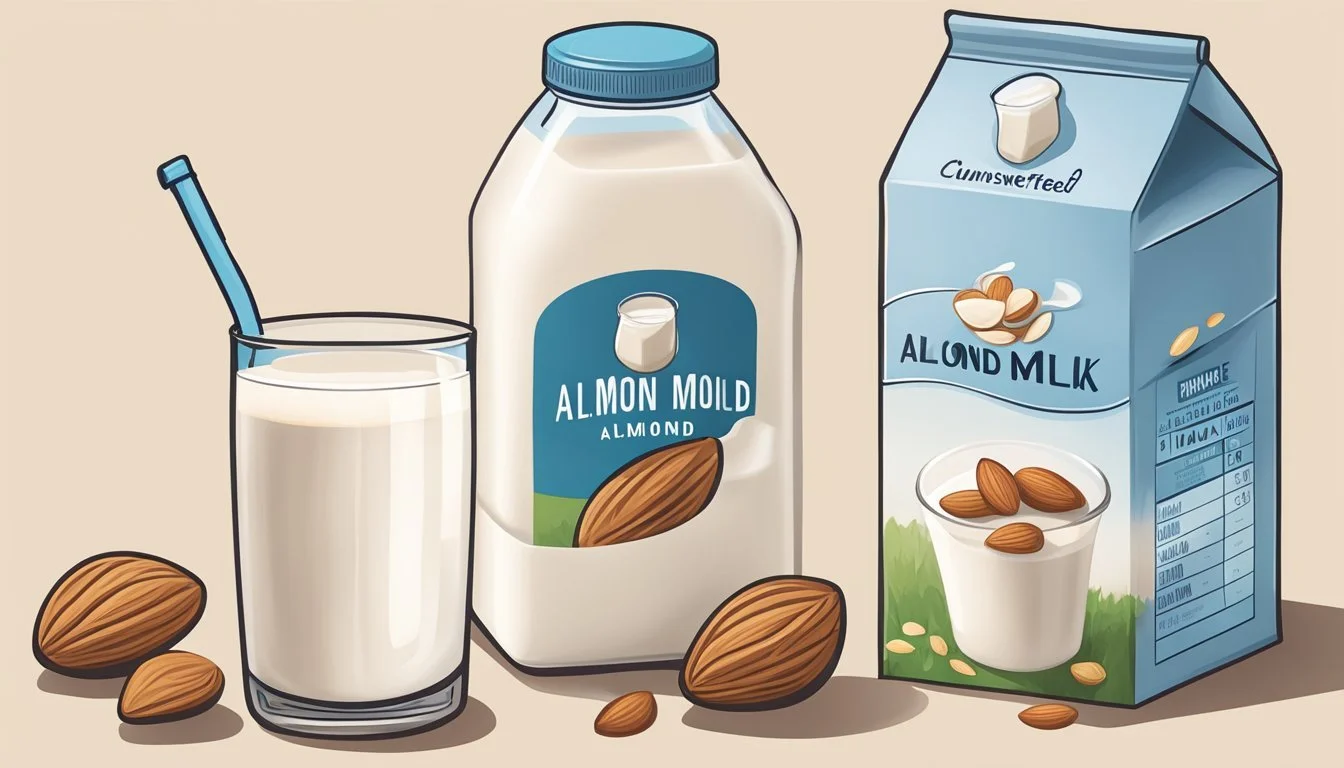How to Substitute Unsweetened Almond Milk for Whole Milk
A Guide for Dairy-Free Baking
Substituting unsweetened almond milk for whole milk in various recipes offers a dairy-free alternative for those who are lactose intolerant, allergic to cow's milk, or following a vegan diet. Unsweetened almond milk is low in calories and fat compared to whole milk, and it can serve as a nutritious substitute in cooking and baking. It is essential, however, to understand how this swap might affect the flavor, consistency, and structure of your dishes.
When using unsweetened almond milk as a substitute in recipes that traditionally call for whole milk, a one-to-one ratio is typically a safe starting point. This means that if a recipe requires one cup of whole milk, one can replace it with an equal amount of almond milk. This direct substitution generally works well for both sweet and savory dishes. However, due to differences in protein and fat content, there may be slight variances in taste and texture that could affect the end product.
In baking, the properties of whole milk, which contribute to the moisture, browning, and richness of baked goods, may not be entirely replicated by almond milk. Adjustments might be necessary to achieve a similar result, such as reducing added sugars, since some brands of almond milk have added sweeteners, or slightly altering cooking times. Monitoring and tweaking these components helps in creating a successful final dish that closely mirrors the characteristics of using whole milk.
Understanding Milk Substitutions
When substituting unsweetened almond milk for whole milk, it's important to consider the properties of almond milk and how it compares to whole milk in terms of nutritional benefits, taste, and texture.
Almond Milk Properties
Unsweetened almond milk is a popular plant-based alternative to dairy milk, particularly favored by those following a vegan diet. Almond milk typically contains a blend of ground almonds and water, and it may also include stabilizers to improve its shelf life and texture. It generally has a lower calorie count compared to whole milk, primarily because of its lower fat content.
Almond milk is enriched with vitamins and minerals such as calcium and vitamin E to mimic the nutritional profile of whole milk. However, it's naturally low in protein and doesn't contain lactose, making it suitable for those with lactose intolerance. The flavor of almond milk is distinctly nutty and can be noticeably different from the rich, creamy taste of whole milk.
Comparing Almond and Whole Milk
Almond Milk Whole Milk Fat Low, contains heart-healthy fats High, contains saturated fats Protein Low High Flavor Nutty, characteristic of almonds Creamy, less pronounced flavor Texture Lighter, less viscous Rich, creamy Lactose Lactose-free Contains lactose Vitamins & Minerals Often fortified with calcium and vitamin E Naturally contains a variety of vitamins and minerals including calcium and vitamin B12
The nutritional benefits of almond milk as an alternative to whole milk include its suitability for those with lactose intolerance and its lower fat content. However, those who require higher protein intake or have a nut allergy may find whole milk to be the better option. In terms of texture, almond milk is less creamy than whole milk, which can affect the mouthfeel and final appearance of certain recipes, such as soups and sauces.
It is also essential to note that while unsweetened almond milk can lack the inherent sweetness of whole milk, it can be a preferred choice for those looking to reduce sugar intake. When using unsweetened almond milk as a substitute in cooking and baking, adjustments in the recipe might be necessary to achieve the desired final product.
Benefits of Using Almond Milk
Almond milk serves as a versatile and beneficial substitute for whole milk, catering to dietary restrictions and environmental concerns.
Health and Dietary Benefits
Almond milk is an excellent choice for individuals seeking health and dietary benefits. Being lactose-free, it is suitable for those who are lactose intolerant, reducing the risk of digestive discomfort. As it’s a plant-based option, almond milk fits well into a vegan diet. In terms of nutritional content, unsweetened almond milk typically contains fewer calories than whole milk, which can be beneficial for weight management. Additionally, it has no cholesterol, making it a heart-friendly choice.
Environmental and Ethical Considerations
Choosing almond milk also reflects a commitment to environmental and ethical considerations. Its plant-based nature makes it a cruelty-free alternative, avoiding the animal welfare concerns present in traditional dairy farming. From a sustainability perspective, producing almond milk generally requires less water and land compared to dairy milk, contributing to sustainable agricultural practices. However, it’s important to note that almonds themselves are water-intensive crops, so it is vital for consumers to choose brands that practice responsible water management.
Preparation Strategies for Almond Milk Substitution
In substituting unsweetened almond milk for whole milk, one must account for differences in fat content, texture, and nutritional composition to achieve the desired result in cooking or baking.
Adjusting Ratios and Measurements
When substituting unsweetened almond milk for whole milk in recipes, the standard ratio is a one-to-one substitution. This means if a recipe calls for one cup of whole milk, one can typically use one cup of unsweetened almond milk as a direct replacement. However, due to the lower fat content and thinner consistency of almond milk, some adjustments may be necessary:
For Baking: To mimic the richness that whole milk provides, consider adding a small amount (such as a tablespoon) of oil or fat to compensate for the lower fat content in almond milk.
For Cooking: If a recipe requires the milk to act as a thickening agent, a thicker substance like a flour or cornstarch slurry might be needed in tandem with almond milk.
Considering Almond Milk Varieties
Almond milk comes in various forms: unsweetened, sweetened, and flavored. For most cooking and baking purposes, unsweetened almond milk is the preferred choice since it doesn't introduce additional sugars to the recipe, which can affect the final product.
Texture and Fortification: Some brands offer almond milk that is fortified with additional minerals and vitamins, which can help in mirroring the nutritional profile of whole milk. Look for almond milk varieties that are fortified with calcium and vitamin D.
Protein Content: Whole milk contains more protein compared to almond milk. To account for this, one may consider integrating other protein sources into the recipe if this macronutrient is essential.
Flavored Varieties: Use flavored almond milk with caution, as it could impart unintended tastes to your dish. Unsweetened varieties are more versatile and predictable in terms of end flavor.
Recipe Adjustments for Almond Milk
Substituting almond milk for whole milk requires careful consideration of the recipe's moisture, fat content, and flavor profile. Almond milk is lower in fat and has a nutty flavor that can influence the taste and texture of the final dish.
Baking with Almond Milk
When using almond milk in baking, keeping the consistency and fat content similar to that of whole milk is crucial. Consider the following:
Muffins, Pancakes, Waffles: Use a 1:1 ratio when substituting almond milk for whole milk.
Fat Content: Since almond milk is lower in fat than whole milk, one might add a small amount of oil to compensate, especially in desserts.
Flavor: Almond milk has a distinct nutty flavor; if a recipe requires a neutral taste, use unsweetened almond milk and modify the recipe by adding a flavoring agent if needed.
Baking Time: The lower fat content in almond milk could potentially affect the baking time. Monitoring the baking process closely may be necessary to avoid under- or over-cooking.
Example Adjustment: To make a standard muffin recipe using almond milk:
Substitute 1 cup whole milk with 1 cup unsweetened almond milk
Add 1-2 tablespoons of vegetable oil to provide additional moisture and fat.
Cooking with Almond Milk
Almond milk can be incorporated into savory dishes just as well as baking. Here are tips for using almond milk in cooking:
Casseroles and Soups: Use a 1:1 substitution ratio, but if the recipe requires thickening, flour or another thickening agent might be needed.
Creamy Sauces: Due to the lower fat content, sauces may not be as rich. Thickening agents or a reduction technique can address this issue.
Flavor: Be aware of the nutty undertones in almond milk when cooking savory recipes. Taste and adjust seasonings as necessary to achieve the desired flavor.
Example Adjustment: For a creamy casserole:
Substitute each cup of whole milk with 1 cup of unsweetened almond milk.
Mix in an additional tablespoon of all-purpose flour to achieve the right consistency.
Troubleshooting Common Issues
When substituting unsweetened almond milk for whole milk, bakers may encounter issues with texture and consistency, as well as flavor balance. The following subsections aim to provide targeted solutions for these specific challenges.
Texture and Consistency Challenges
Unsweetened almond milk is naturally thinner than whole milk. To achieve a similar consistency, one may need to add a thickening agent. Here are common fixes:
Cornstarch: Mix 1 to 2 teaspoons of cornstarch with cold almond milk before adding it to your recipe.
Flour: A tablespoon of all-purpose flour per cup of almond milk can also help thicken the mixture.
When heat is applied, these agents will help to thicken the almond milk, emulating the body of whole milk.
Flavor Balance Considerations
The lack of sweetness and the subtle nutty flavor of unsweetened almond milk can alter the taste of recipes designed for whole milk. Adjustments may include:
Sweeteners: Incorporate additional sweeteners like sugar, honey, or a preferred alternative to compensate for any lost sweetness.
Vanilla: A dash of vanilla extract can enhance the overall flavor profile, complementing the nuanced taste of almond milk.
It's essential to add sweeteners cautiously and taste test when possible to prevent overpowering the dish with sweetness.
Almond Milk in Special Diets
When considering almond milk as a substitute for whole milk, it is important to understand how it fits into special diets, addressing concerns such as allergens while providing nutritional benefits to those with dietary restrictions.
Dietary Restrictions and Allergies
Almond milk is a dairy-free and lactose-free alternative, making it suitable for individuals with lactose intolerance or dairy allergies. However, it is crucial to note that almond milk is not suitable for those with nut allergies. In terms of nutrients, unsweetened almond milk contains fewer calories than whole milk, but it is typically fortified with nutrients like vitamin A and calcium. This fortification helps individuals with dietary restrictions maintain balanced nutrition.
For those who have a gluten-free diet, almond milk is inherently gluten-free, but consumers should always check the label for any additives that might contain gluten. Most brands ensure their almond milk is safe for gluten-restricted diets, but caution is always advised.
Integrating into Vegetarian and Vegan Diets
For individuals following plant-based diets, including vegetarian and vegan, unsweetened almond milk provides a valuable source of nutrition. As these diets exclude animal products, almond milk serves as an excellent plant-based milk alternative. It's free from animal-derived ingredients and is often enriched with essential nutrients that may be more challenging to obtain from plant-based foods alone.
Nutrients Benefit Vitamin E Antioxidant properties Vitamin D Bone health, when fortified Calcium Bone health, when fortified
Almond milk can contribute to the intake of these nutrients while also offering a low-calorie and plant-based option that complements a vegan or vegetarian lifestyle. Additionally, some almond milk varieties offer boosted levels of iron and other minerals to help meet daily nutritional requirements.
Alternatives and Substitutions
When replacing unsweetened almond milk with whole milk in recipes, it is important to understand how various non-dairy milks can impact taste, texture, and nutritional content.
Using Different Non-Dairy Milks
Non-dairy milks differ in flavor and consistency, which can affect the final product. Here are suitable substitutes:
Soy Milk: A one-to-one substitute for almond milk. Soy milk's protein content is closest to that of whole milk, making it suitable for baking and cooking.
Oat Milk: Creamier and slightly sweeter, oat milk can replace almond milk in most recipes without significantly altering the outcome.
Coconut Milk: With a distinct taste, it works well in desserts and smoothies. Use thinner, beverage-style coconut milk rather than canned, full-fat version.
Skim Milk: For those not strictly dairy-free, skim milk could serve as an alternative, providing a lower fat content similar to almond milk.
Converting Recipes for Non-Dairy Options
To convert recipes that call for dairy to non-dairy alternatives:
Heavy Cream: Mix dairy-free milk with oil. For each cup of heavy cream, use 2/3 cup of soy or oat milk with 1/3 cup of a light oil.
Buttermilk: Mix 1 tablespoon of vinegar or lemon juice with 1 cup of soy or coconut milk, allowing it to sit for a few minutes to curdle before use.
Custards (how long do custards last?) and Puddings: Non-dairy milks can be used, but the custard may be less rich. Use full-fat coconut milk for creamier textures.
Baking: Oat or soy milk can often be substituted in a 1:1 ratio for whole milk. Monitor the wetness of the batter as some non-dairy milks are thinner.
Smoothies: All non-dairy milks are suitable for smoothies; choose based on preferred flavor profile and consistency.
Purchasing and Storing Almond Milk
When selecting unsweetened almond milk, consumers should prioritize reading the nutrition facts label. Store-bought almond milk commonly comes in unsweetened vanilla flavor, which is often preferred because it imparts a subtle taste without adding sugar.
Where to Purchase:
Natural food stores
Supermarkets
Organic food sections
Choosing Almond Milk:
Opt for natural or organic varieties
Check for additives and preservatives
Ensure the package is sealed correctly
After purchase, storing almond milk correctly is crucial for maintaining its shelf life and freshness. Unopened almond milk can be stored in a cool, dark pantry until the best-before date. Once opened, it should be kept in the refrigerator to prevent spoilage.
Storing in the Refrigerator:
Preferably, keep at the back where the temperature is more consistent
Use within 7-10 days of opening
To extend its usability further, almond milk can be frozen, although this might slightly alter the texture.
Freezing Tips:
Store in airtight containers or ice cube trays
Thaw in the refrigerator before use
Always engage senses to test for freshness; almond milk that tastes sour or has changed texture should be discarded. It's advised to shake the container before each use, as almond milk can separate over time.





